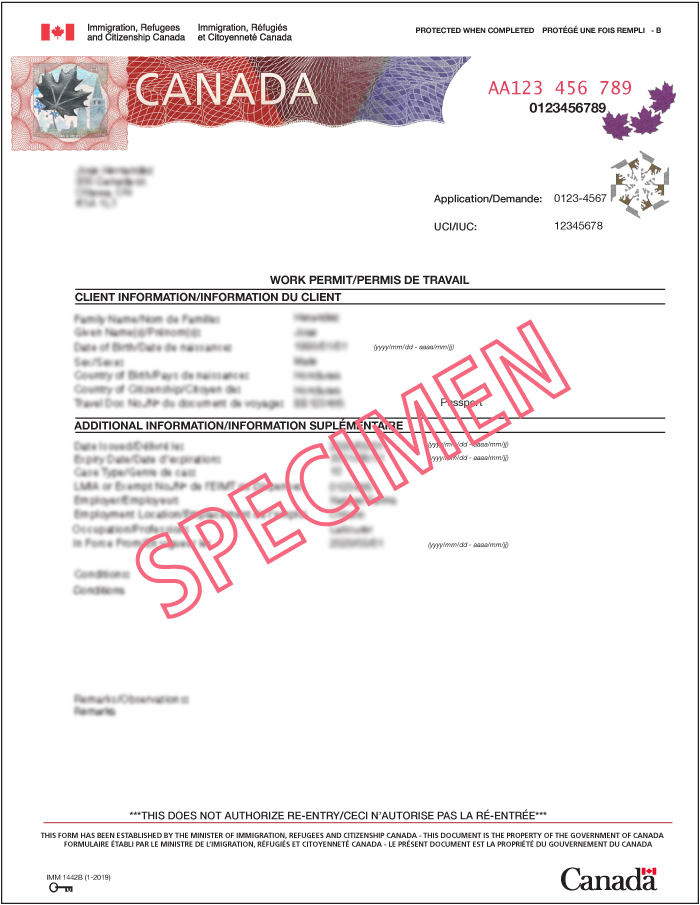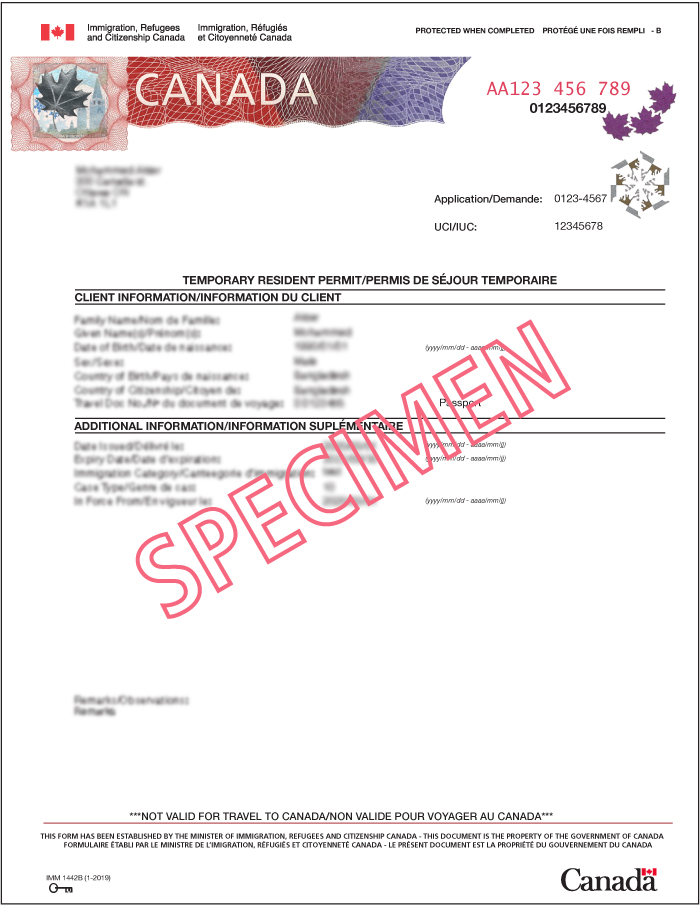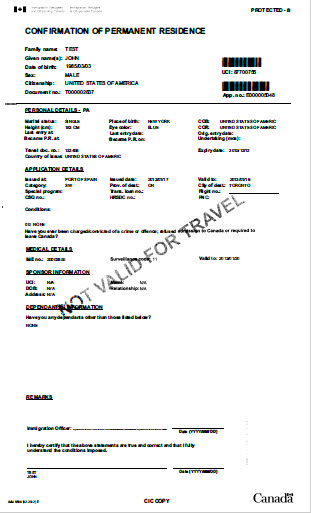Types of immigration documents
We issue many types of immigration documents. Entry documents are used to travel to Canada and seek entry. Status documents are used to demonstrate status as a worker, student, visitor (extended stay), permanent resident or refugee in Canada. Status documents can also be used to prove a foreign national’s status when applying for federal or provincial services and other benefits.
On this page
- Entry documents
- Status documents
Entry documents
Most foreign nationals need an entry document to travel to Canada or transit through the country. There are 2 types of entry documents:
- a visa (sometimes called a temporary resident visa, a permanent resident visa, a counterfoil or a visitor visa)
- an electronic travel authorization (eTA)
Entry documents are not the same as status documents. A foreign national also needs a status document to work or study in Canada or to immigrate to the country.
Visa (counterfoil)
A visa (counterfoil) is an official document that’s placed in a foreign national’s passport. It proves they meet the requirements to travel to Canada. The visa allows the foreign national to present themselves at a Canadian port of entry for examination to determine if they can enter the country. It does not guarantee entry into Canada.
The expiry date of the counterfoil is the last date the foreign national can use it to travel to Canada. It does not indicate the date by which they must leave. See How long can I stay in Canada as a visitor.


Electronic travel authorization (eTA)
An eTA is an entry document used by visa-exempt foreign nationals travelling to Canada by air. An eTA is electronically linked to a traveller’s passport. We do not issue a physical eTA document.
An eTA is valid for up to 5 years or until the foreign national’s passport expires, whichever comes first.
Status documents
An immigration status document can be used
- as proof of your status in Canada
- as proof of historical immigration information, including the date and place of entry to Canada
- to access federal, provincial and municipal social benefits and services
If you’re a business owner who accepts these documents as part of your business, it’s important you know how to recognize them.
Temporary residents (IMM 1442)
We issue the IMM 1442 document to all temporary residents authorized to enter and remain in Canada.
The contents of the IMM 1442 depend on the resident’s status. We issue documents for
- study permits
- work permits
- visitor records
- Temporary Resident Permits (TRP)
These documents cannot be
- used for travel
- used as an identity document
- laminated or altered in any way (altered or laminated documents are not valid)
We have started issuing a new version of the IMM 1442 document. Check the sections below for current examples of these documents.
Previous version of IMM 1442
Some temporary residents may have been issued the previous version of the document. If the expiry date on the document has not passed, the document is still valid.
Example of a previous version
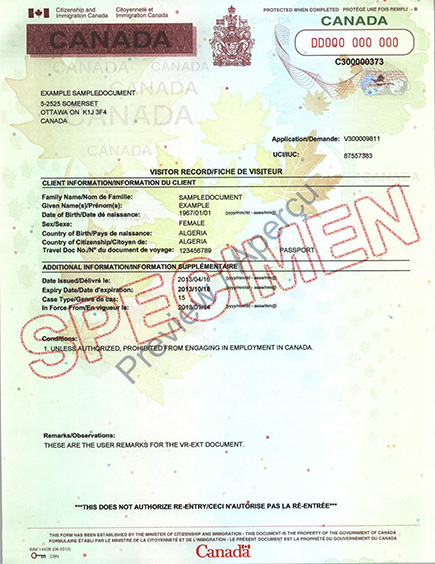
Study permit
We issue study permits to foreign nationals so they can study at designated learning institutions (DLIs) in Canada, usually for periods longer than 6 months.
It includes
- the institute where they study
- if their travel within Canada is restricted
- the date they need to leave Canada
Learn more about study permits.
Work permit
Example of a work permit (new version as of September 17, 2024)
You can also see an example of the previous version of a work permit.
We issue work permits to foreign nationals so they can work in Canada. Most foreign nationals need a work permit to legally work in Canada.
It includes
- the type of work they can do
- the employer they can work for
- where they can work
- how long they can work (up to 5 years)
Learn more about work permits, including
Visitor record
A visitor record is an official document that is issued to some visa-required and visa-exempt foreign nationals to
- limit or extend their stay in Canada
- specify conditions during their stay
It includes
- the conditions of their stay
- the date by which they must leave Canada
- the purpose of their stay in Canada
A visitor record is not a visa and doesn’t authorize re-entry into Canada if the visitor leaves.
Learn more about visitor records.
Temporary Resident Permit
Example of a temporary resident permit.
We issue Temporary Resident Permits (TRP) under exceptional circumstances to foreign nationals who are inadmissible. They grant special authorization to enter or remain in Canada temporarily.
TRPs are usually valid for between 6 and 12 months.
Learn more about inadmissibility.
Refugee documents
Refugee protection claimant document
Example of a refugee protection claimant document
We issued refugee protection claimant documents (RPCDs) to refugee claimants before March 25, 2025, after we had referred their claims to the Immigration and Refugee Board of Canada (IRB) or, if we deemed their claim was ineligible to be referred, but eligible to apply for a pre-removal risk assessment (PRRA).
An RPCD
- confirms you either
- made a refugee claim (either eligible or not), or
- have been referred to the Immigration and Refugee Board of Canada (IRB)
- shows you’re covered for health coverage under the Interim Federal Health Program (IFHP)
An RPCD does not
- explain the conditions for health coverage
- provide the authorized period of stay and length of health coverage
Learn more about claiming refugee status in Canada.
Refugee protection identity document
Example of a refugee protection identity document
As of March 25, 2025, we issue refugee protection identity documents (RPIDs) to refugee claimants after we refer their claims to the Immigration and Refugee Board of Canada (IRB) or, if we deemed their claim was ineligible to be referred, but eligible to apply for a pre-removal risk assessment (PRRA).
An RPID
- confirms you made a refugee claim in Canada
- shows you’re covered for health coverage under the Interim Federal Health Program (IFHP)
A RPID does not
- explain the conditions for health coverage
- provide the authorized period of stay and length of health coverage
Learn more about asking for refugee protection in Canada.
Permanent Residents
Confirmation of Permanent Residence (IMM 5292 or IMM 5688)
Example of a Confirmation of Permanent Residence.
We issue a Confirmation of Permanent Residence (CoPR) to foreign nationals either
- before they travel to Canada, or
- when they land in Canada
It confirms their permanent resident status before they get their permanent resident card.
The CoPR includes
- the official date of landing
- where they landed
- medical exam details
- any conditions of stay
Learn more about permanent resident status.
Permanent resident card
A permanent resident (PR) card proves that the holder has permanent resident status in Canada. If they travel abroad, they must show this card and their passport to return to Canada.
Learn more about permanent resident cards.

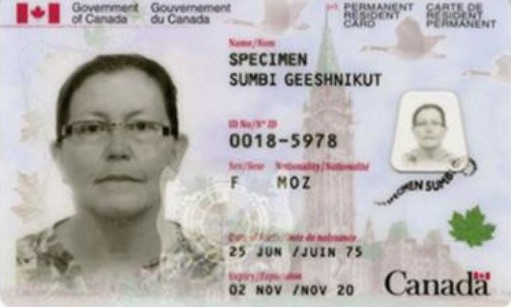
Verification of Status (IMM 5009)
We issue verification of status (VOS) documents to foreign nationals, permanent residents or Canadian citizens when their original status document has been
- lost
- stolen
- destroyed
The VOS document
- confirms the holder’s current immigration status
- provides information about the holder’s immigration history
- gets printed on plain paper


